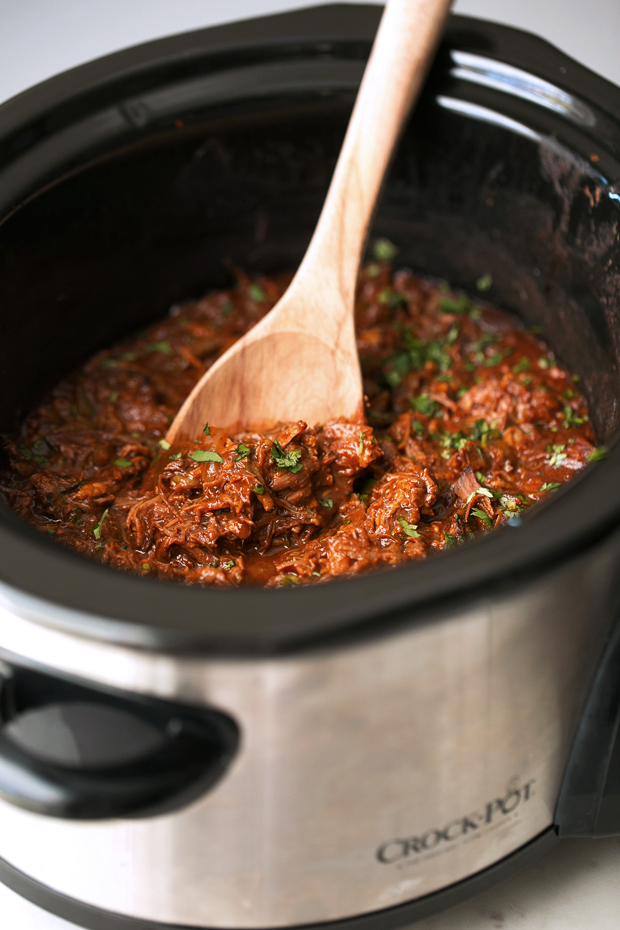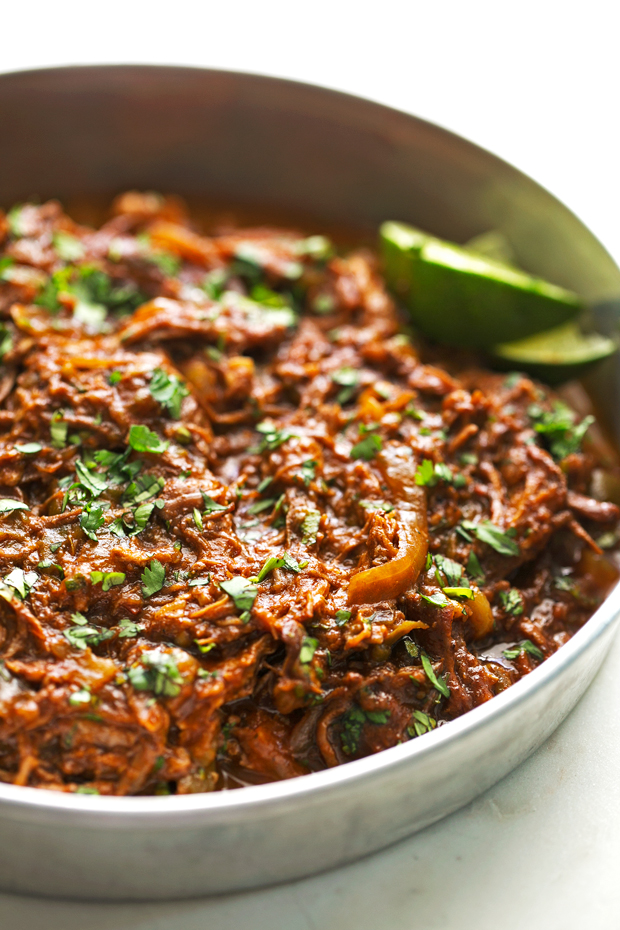Ropa Vieja is one delish Cuban dish! And a lot fancier sounding than the amount of energy actually required to make this dish. Because let’s face it, we’re talking about a quick sear on the meat and into the slow cooker or instant pot it goes! Out comes braised, cuban shredded beef that is falling apart tender and delicious with rice, on tacos, and even with eggs and black beans for breakfast. Or maybe mixed in with migas. This recipe is a dream for chilly evenings in the fall. Warm, cozy, comforting, meaty, and saucy. The tomato sauce seasoned with oregano, cumin, and garlic adds such a nice balanced warmth to the dish. Plus there’s the whole thing about not having to turn on the oven and just a quick 10 minutes of stovetop. If you’re making this in a a pressure cooker, you don’t even have to turn on the stove. Just sear the beef on the saute setting before setting it to pressure cook. It’s a cozy bowl served with smashed sweet plantains, slow simmered black beans, all served on a bed of white rice. Cuban shredded beef is my jam.
So what is Cuban shredded beef (Ropa Vieja)?
Literally translated ‘Ropa Vieja’ means old clothes. And it’s the most amazing braised Cuban shredded beef of your life. Start with flank steak or chuck roast. Then you simmer it in a homemade tomato-based sauce. And what you’re left with is a shredded beef stew-ish type dish that you didn’t even know you were missing.
Ingredients for homemade Ropa Vieja recipe
Beef: I suggest using a tough cut of meat that does well with braising. Flank steak, chuck roast and or any other type of meat that requires a slow cooked method. Garlic: You’ll want to insert a few of the garlic cloves into the meat so that it flavors the inside. The rest gets chopped up and used for the sauce portion of the recipe. Avocado oil: Or any high heat oil works here. This is simply to sear the meat. You can do this over medium-high heat in a dutch oven if you are slow cooking this in a crock pot. Or feel free to just saute in the pan of your pressure cooker. Tomato sauce: Is the base of the ropa vieja sauce. Green bell pepper: Thinly slice the peppers, then stir them into the sauce ingredients. They’ll cook up nicely with the onions and green chilies. Onion: You’ll want to thinly slice your onions for this recipe. Feel free to use a yellow or white onion! Chopped green chilies: The stuff that comes in a can, is exactly what you need. They usually have it near the pickled peppers section of the grocery store. You’ll need a 4 ounce can. Tomato paste: Just gives the recipe a concentrated shot of tomato paste! Seasonings: You’ll need ground cumin, dried oregano, salt, and red pepper flakes. Feel free to toss in a couple bay leaves if you’d like! White vinegar: This helps tenderize the meat so that it’s fall apart tender. Beef Broth: This is an ingredient that you would just need if you were making this recipe in the instant pot or pressure cooker. It helps build adequate steam in the pressure cooker so that the meat cooks through without burning and sticking to the bottom. Cilantro: This helps add color and flavor because we eat with our eyes first! Optional ingredients: Some people like to use capers or green olives for this recipe, but I’ll be honest, I save those for when I make Picadillo!
How to make Cuban shredded beef:
That’s it. It’s seriously the easiest dinner ever and you can start it right before you go to work and have it ready and waiting for you when you get home. Perfect, tender, and a crowd pleaser. And seriously, the comfort factor — it’s to a whole new level. I serve it on a bed of cilantro lime rice with a side of cuban-style black beans. And obvi, in 10+ years we’ve been together now, you know I need tons of chopped cilantro and lime wedges to serve on the side. That’s how we do. ✌️
If you like this recipe, you might also like:
Cuban Mojo Chicken Quinoa Bowls with Mango Salsa Cuban Black Beans with Cilantro and Lime Very Best Cuban Black Bean Soup Marinated Mojo Steak Tacos with Quick Guac
Leftover beef can be kept in an airtight container and refrigerated for up to 5 days or frozen for up to 2 months.






